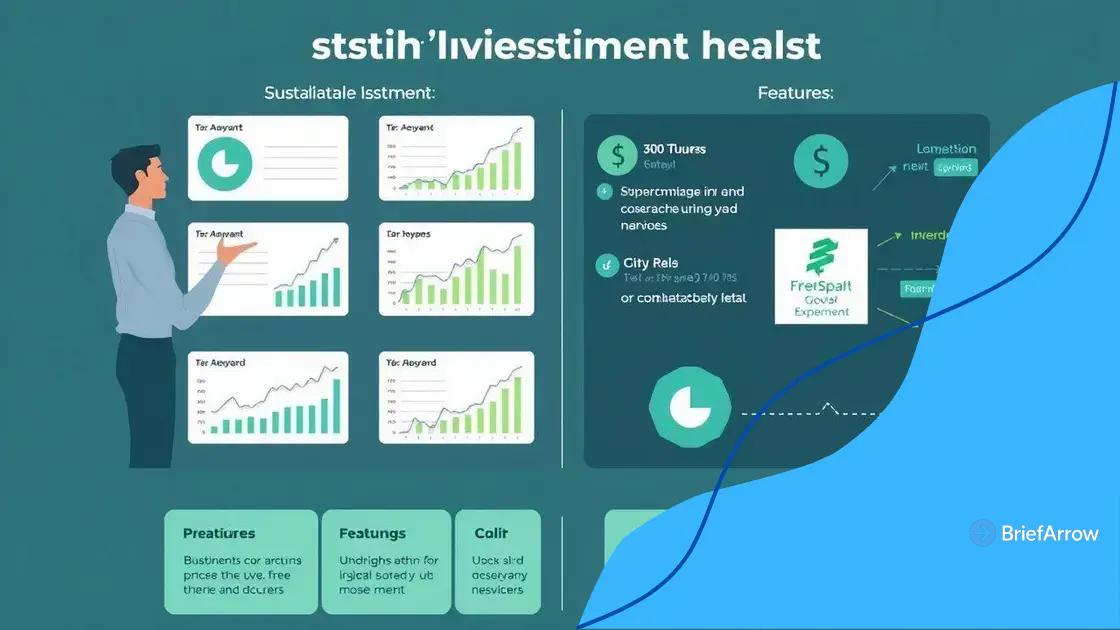Rise of sustainable investing platforms gaining momentum

Anúncios
Rise of sustainable investing platforms empowers investors to make choices that deliver both financial returns and positive environmental and social impacts.
Rise of sustainable investing platforms is shaping the way we think about finance and its impact. As more investors seek to make a difference, these platforms provide opportunities to align investments with personal values.
Anúncios
Understanding sustainable investing platforms
Understanding sustainable investing platforms is essential for modern investors who want to align their financial choices with their values. These platforms allow individuals to invest in companies and projects that prioritize environmental, social, and governance (ESG) factors. By utilizing these platforms, anyone can contribute to a more sustainable future.
What are Sustainable Investing Platforms?
Sustainable investing platforms are online services that connect investors with sustainable investment opportunities. They offer various financial products that focus on sustainable practices. This includes green bonds, environmentally-friendly funds, and socially responsible investments. Such options are designed to generate a positive impact alongside financial returns.
Benefits of Using These Platforms
Investing sustainably comes with numerous advantages. Here are some key benefits:
Anúncios
- Alignment with personal values.
- Contribution to positive social and environmental outcomes.
- Potential long-term financial growth.
- Diversification of investment portfolio.
Moreover, many sustainable investing platforms provide educational resources. They help investors understand the impact of their investments. This knowledge can empower individuals to make informed choices. Understanding more about the sustainable practices of companies can enhance investor confidence.
How They Work
Most sustainable investing platforms function similarly to traditional investment platforms. After registering an account, users can browse different investment opportunities. They can filter options based on sustainability criteria, such as renewable energy projects or fair-trade businesses. Additionally, many platforms include performance trackers to monitor both financial and impact results.
Furthermore, automated investing features simplify the process. Users can set goals and automatically diversify their investments across various sustainable projects.
As the demand for sustainable investments rises, more platforms are emerging. This growth is evident in the increasing number of products focusing on sustainability.
Challenges of Sustainable Investing
Despite the rise in sustainable investing options, challenges exist. Some investors may find it difficult to gauge how truly sustainable a company is. Also, the performance of sustainable investments can vary. However, continuing education and awareness can improve understanding and lead to better decision-making.
Key benefits of sustainable investing
The key benefits of sustainable investing are attracting many investors who want to make a positive impact. One major advantage is aligning investments with personal values. This alignment helps investors feel more connected to their financial choices.
Financial Performance
Research shows that sustainable investments can perform just as well as traditional investments. Companies that prioritize sustainability often see improved financial outcomes. They manage risks better and can adapt to changing market demands.
Promoting Social Good
Investing sustainably allows individuals to contribute to positive social and environmental change. Here are some benefits:
- Encourages fair labor practices.
- Supports renewable energy projects.
- Promotes sustainable agriculture.
- Enhances community development.
As individuals invest in companies focused on sustainability, they help drive the demand for ethical business practices. This leads to a healthier planet and society.
Long-Term Growth Potential
The market for sustainable investing is expanding. Many analysts predict that this trend will continue to grow. By investing early in sustainable platforms, individuals can capture long-term growth opportunities. They are likely to benefit from promising sectors like renewable energy and technology.
Moreover, investors are increasingly aware of climate risks. By choosing sustainable options, they help protect their portfolios from potential downturns related to environmental issues.
Diversification
Another significant benefit is portfolio diversification. Sustainable investing opens up various sectors, reducing risks associated with traditional investments. By spreading investments across different areas, like technology, healthcare, and green energy, investors create a more balanced portfolio.
This balance can lead to more consistent returns and lower volatility. A diverse portfolio not only reduces risks but also enhances the overall investment experience.
How to choose the right platform

Choosing the right sustainable investing platform is a crucial step for anyone who wants to make impactful financial decisions. With many options available, it’s important to consider quality and sustainability criteria. A good platform should fit your investment goals and values.
Assess Your Values
Start by identifying what matters most to you. Do you want to focus on environmental issues, social equality, or corporate governance? Knowing your values will help you select a platform that aligns with your principles.
Research Platform Features
Each platform may offer different features that cater to various investor needs. Look for key aspects:
- User-friendly interface.
- Variety of investment options.
- Educational resources and tools.
- Transparency in fees and performance.
Reading user reviews can provide insight into the platform’s reliability and ease of use. If a platform offers comprehensive educational materials, it can enhance your understanding of sustainable investing.
Evaluate Investment Options
Not all platforms offer the same investment choices. Look for those that provide a range of options, including stocks, bonds, and mutual funds that focus on sustainability. This diversity allows you to build a well-rounded portfolio aligned with your values.
Additionally, some platforms might provide options to invest in specific sectors, such as renewable energy or socially responsible companies. This enables you to target your impact effectively.
Understand Fees and Costs
Always review the fee structure of each platform. Platforms can charge different fees for services, including transaction fees, management fees, and subscription costs. Lower fees can increase your return on investment over time.
Compare the fee structure with the value offered. A platform with higher fees may provide better resources and investment choices. Choose wisely, ensuring that you are receiving a good value for your investments.
Challenges faced by investors
Investors in sustainable platforms often encounter various challenges. Understanding these hurdles is essential for making informed decisions. One common challenge is the difficulty in measuring a company’s sustainability performance. It can be hard to find reliable data that showcases how well a company implements its sustainable practices.
Limited Availability of Information
Many sustainable companies do not disclose all their practices. This lack of transparency can frustrate investors who want to assess their impact. Investors need to conduct thorough research to find credible sources of information that align with their values. This process can take time and effort.
Risk of Greenwashing
Another significant concern is greenwashing. Some companies may market themselves as sustainable without following through on their promises. This misleading information can confuse investors. To avoid falling for greenwashing, look for companies with third-party certifications or transparent sustainability reports.
Market Volatility
Investing in sustainable projects can also present risks, just like any other investment. The market for sustainable investments can be volatile. Changes in regulations or public interest can impact the performance of these investments. It’s essential to be prepared for fluctuations and to have a long-term perspective.
Moreover, sustainable investments often require patience, as positive outcomes might take longer to develop. Investors must be willing to stay committed even when facing short-term challenges.
Balancing Values and Returns
Finding a balance between personal values and potential returns can be difficult. Some investors may worry that sustainable investments will yield lower returns than traditional ones. However, many studies show that sustainable companies can perform as well, if not better, over time. Educating oneself about the performance of sustainable options can alleviate this concern.
Ultimately, staying informed and being aware of the challenges can prepare investors to navigate this space effectively and make choices that reflect their values.
Future trends in sustainable investing
Future trends in sustainable investing are shaping the financial landscape in exciting ways. As more people become aware of environmental and social issues, the demand for sustainable investments is expected to rise. This shift creates new opportunities for investors and companies alike.
Increased Transparency
One major trend is the push for greater transparency among companies. Investors are demanding detailed reports on how businesses operate sustainably. As a response, more companies are adopting stringent reporting standards to showcase their sustainable practices. This increase in transparency will help investors to make more informed decisions.
Technological Advancements
Technology is playing a key role in sustainable investing. New platforms are emerging that utilize artificial intelligence and big data to assess the sustainability of investments. These advancements make it easier for investors to identify and engage with sustainable projects. Innovative tools and apps allow investors to track the impact of their investments in real time.
Rise of Impact Investing
Another trend is the rise of impact investing. More investors are looking to generate not just financial returns, but also social and environmental impact. This approach means that investors prioritize businesses that contribute positively to society, creating a win-win situation. According to recent studies, impact investments have demonstrated strong performance, attracting even more capital.
This shift towards impact investing encourages companies to focus on solutions to pressing global challenges, from climate change to poverty alleviation. The growing awareness of these issues will continue to influence investment decisions.
Integration of ESG Factors
Environmental, social, and governance (ESG) factors are increasingly being integrated into investment strategies. Investors are looking beyond financial metrics and considering ESG criteria when assessing investment options. This holistic approach is becoming a standard practice for many investment funds and portfolios.
Investors are realizing that companies performing well on ESG indicators tend to be more resilient and have lower risks over time. As a result, the integration of ESG factors will likely shape future investment landscapes.
Regulatory Changes
Regulatory changes are also expected to impact sustainable investing. Governments worldwide are implementing new regulations to encourage sustainable business practices. These regulations will drive companies to adopt sustainable measures, attracting investor interest. Staying informed about these changes will be crucial for investors looking to navigate the evolving landscape.
FAQ – Frequently Asked Questions about Sustainable Investing
What is sustainable investing?
Sustainable investing focuses on making investment decisions that generate positive environmental, social, and governance (ESG) impacts alongside financial returns.
What are the key benefits of sustainable investing?
The key benefits include potential for strong financial performance, aligning investments with personal values, promoting social good, and helping to combat climate change.
How can I choose the right sustainable investing platform?
To choose the right platform, consider its features, transparency, available investment options, and the alignment with your personal values.
What challenges might I face as a sustainable investor?
Challenges include limited data on sustainability performance, risks of greenwashing, market volatility, and balancing financial returns with ethical considerations.